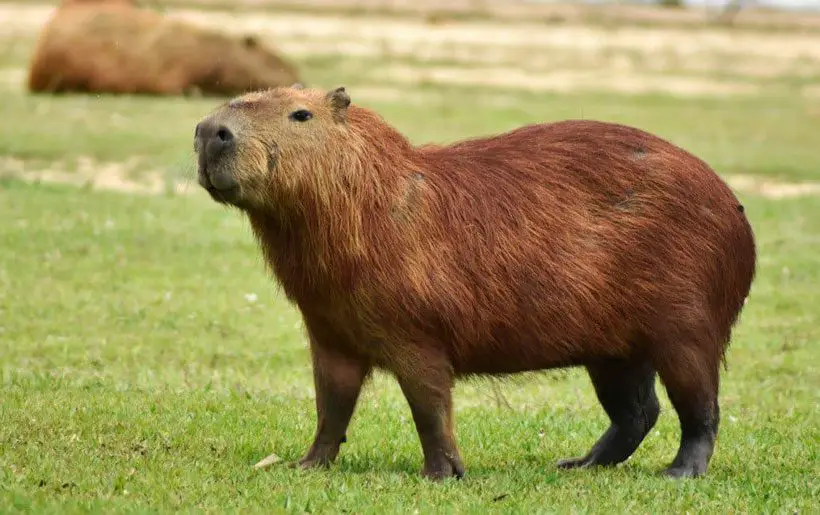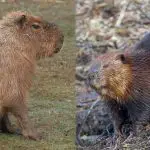Capybara Care 101: Essential Tips for Keeping Your Pet Healthy and Happy
If you are lookig for an adorable pet, Capybaras may seem like an appealing option because of their friendly demeanor in the wild, but don’t be fooled- they are not exactly easy to domesticate.
Even though capybaras are social creatures who enjoy the company of others, it takes a lot of time and patience to win their trust and develop a bond with them. Therefore, it is essential to know how to properly care for your furry pet in order to ensure their satisfaction and general welfare.
So, how should you care for your pet Capybara? You should provide your pet Capybara with frequent grooming, hay, fresh vegetables, and fruits to eat. Also, ensure daily exercise, mental stimulation, and normal veterinary care in order to keep it healthy and happy.
In this article, we have covered essential details about caring for your cute pet. Learn more about their unique traits, get the inside scoop on their diet and nutrition, and get tips on grooming and health care. So, let’s get going!
Importance Of Proper Care For Your Pet Capybara
Capybaras are quite a sight to behold, with a stocky, barrel-shaped body, short, strong legs, and a rounded-shaped head! Their unusual snout, which has big nostrils and a dense coat of dark brown fur, is useful for swimming and diving.
Although they tend to be amiable and docile, if, under stress, they may become hostile. Naturally, taking care of a Capybara is no easy chore. They need specialized care and a lot of attention, just like any exotic pet.

It is important to take good care of your pet Capybara as they can be vulnerable to a variety of health problems. It’s crucial to arrange frequent checkups with a licensed veterinarian to keep them in peak condition.
This will make it easier to identify any potential health issues and ensure that your Capybara receives proper treatments on time.
Capybaras are active animals that require regular exercise to maintain their physical and mental health. Thus, it’s essential to provide these animals with a sizable enclosure or yard where they can play and move around unrestrictedly.
It is necessary give your pet the right care, a balanced diet and socialization opportunities to maintain their general well-being and to ensure that they can live long and fruitful lives.
Housing for Pet Capybaras: Basic Requirements
Large, gregarious animals like capybaras need a lot of room to move around and investigate. While capybaras can be kept indoors, their primary housing should be outdoors.

An ideal Capybara enclosure should offer plenty of room for them to explore, run, swim, and play. Additionally, Capybaras are social animals so it’s important to house them in pairs or in large groups.
Check out the table below for a breakdown of the key differences between indoor and outdoor housing options for pet Capybaras. The information will help you choose the best environment for your cherished pet.
| Basic Housing Requirements | Indoor Housing | Outdoor Housing |
|---|---|---|
| Flooring | A sturdy, non-slip surface, like concrete or tile, should be used in indoor housing. | The flooring of outdoor housing should be made of grass or soil because Capybaras like to graze and dig. |
| Embellishment | To keep Capybaras physically active, indoor housing should have toys and recreational opportunities. | Outdoor housing should have plenty of natural flora and obstacles, such as logs and pebbles, for Capybaras to explore and play on. |
| Space | The size of the indoor housing should be big enough for the Capybaras to move around. For one Capybara, a space of at least 8 feet by 12 feet is advised. | Outdoor housing should be larger than indoor housing, as Capybaras need to plenty of space to roam and graze. |
| Bedding | You should choose soft, absorbent bedding for indoor housing, like straw or hay. | To give your pet a more natural environment, use bedding made of organic materials like grass, hay, and leaves for outdoor housing. |
| Climate Control | To maintain a cozy temperature and humidity level, indoor housing should be climate-controlled. | Outdoor housing ought to be situated in a region with the right climate, access to water for cooling down, and natural shade. |
| Expense | The initial expense of an indoor home may be lower, but the cost of heating, lighting, and climate control features can make it expensive. | Outdoor housing may require more initial investment, but ongoing maintenance costs are lower. |
Appropriate Diet and Feeding for a Pet Capybara
Your Capybara’s general health and happiness may depend on what you give them. To be in good condition, these herbivores need a diet that is high in fiber and low in fat.
Fresh green shoots are their favorite food because they are grazing animals, but they also like to nibble on aquatic plants, bark, leaves, roots, and fruits.
A research report suggested that tropical grasses are low in both calories and protein. So, it is recommended that young Capybaras be fed feeds that contain greater amounts of both nutrients than grass. You need to be careful not to feed your pet Capybara junk food or food with extra sugar.

Exotic Animal Vets recommends keeping Capybaras away from naturally occurring “sugar” in sweet vegetables and fruit, especially sweetcorn, due to its high sugar level. So, you can only imagine how harmful any diet with added sugar would be for Capybaras.
Therefore, when it comes to feeding your Capybara, be sure to provide them with a balanced diet that satisfies their particular nutritional needs. We have included a table with a list of the vital nutrients you need to provide your pet.
| Nutrients Needed By Capybaras | Daily intake | Purpose Of The Nutrient | Food Source | Feeding Tips |
|---|---|---|---|---|
| Fat | 2-3% (50-100 grams) | Your pet gets energy from fat, which also aids in absorbing fat-soluble vitamins. | Pellets, grains, nuts and seeds. | You should only give your Capybara small amounts of fatty foods and snacks. |
| Protein | 15-20% (50-300 grams) | Protein promotes the immune system and aids in muscular tissue healing in Capybaras. | Spinach, broccoli, green peas, flax seeds, pellets, and beans | Offer a mix of hay, legumes, and fresh grass |
| Fiber | 50-60% (200-500 grams) | A high-fiber diet supports Capyboros’ continued growth and healthy digestion. | Timothy hay, orchard grass hay, oat hay, fresh vegetables, and fresh fruits. | Always provide your Capybara with fresh hay and veggies. |
| Calcium | 1-2% (20-30-mg) | It is essential for strong bones and teeth. | Timothy hay, kale, collard greens, broccoli, green beans. | Try to give your Capybara fresh fruits and veggies every other day. |
| Vitamin C | 30-50 mg per day | Vitamin C helps to maintain Capybara’s healthy skin, immune system, and metabolism. | Fresh grapes, melons, tomatoes, kale, and broccoli. | Feed fresh fruits to your Capybara as treats. |
It is interesting to note that Capybaras have a special digestive mechanism that enables them to digest tough, fibrous plant matter and extract minerals. They have also been observed engaging in coprophagy, or the habit of eating one’s own feces, to further digest and absorb the nutrients from their food.
Additionally, during times of famine or drought, Capybaras participate in caecotrophy. This involves ingesting softer fecal pellets produced in their cecum. These pellets contain beneficial bacteria that support digestion and gut health.
To maintain optimum hydration levels, make sure your pet has access to fresh, clean water at all times. It is preferable to feed capybaras multiple short meals throughout the day rather than one huge meal to maintain their digestion.
This mimics their natural feeding habits and can help prevent any digestive issues.
Tips on Grooming and Maintaining the Hygiene of Your Pet Capybara
To preserve the longevity and happiness of your pet Capybara, it is imperative to keep them clean and healthy. So, to help you maintain the cleanliness and health of your adorable pet, we have provided you with some basic tips:

Clean up the Area Where Your Capybara Lives
Though Capybaras are inherently hygienic creatures, it’s still important to keep their surroundings clean to avoid any potential health risks. It is advised that you clean their enclosure frequently, get rid of any excrement, urine, or dirt, and change the bedding with new items.
As a result, there will be a lower chance of bacterial infections, respiratory troubles, and other health concerns that might develop in a filthy environment.

Regularly Inspect the Eyes of Your Capybara
Capybaras can get eye infections and other illnesses that could be inconvenient or painful. According to a study, an adult male and a newborn female wild capybara were both found to have eye parasitism in Brazil. That caused blindness in both cases.
Thus, you should look out for any signs of erythema, ocular irritation, discharge, or cloudiness in your pet’s eyes. If you see anything unusual, don’t hesitate to take your Capybara to the vet for a checkup.
Maintain the Dental Health of Your Pet
Capybaras have constantly growing teeth, which is why it is essential to keep them clean to prevent dental issues. One way to do this is by providing them with chew toys, which can help scrape off any buildup on their teeth.
Additionally, crunchy vegetables such as carrots can also help keep their teeth clean.
Trim the Nails of Your Pet
Capybaras’ nails can be quite sharp, which can cause scratches or even injuries to other pets or humans. Therefore, it is important to trim your pet’s nails regularly to avoid any accidents.
You should aim to trim their nails about once a month to keep them at a safe length. This will not only prevent scratches but also help your Capybara maintain healthy feet.
Give Your Capybara a Nice Bath
Capybaras don’t need to take frequent showers because they are excellent swimmers and enjoy being in the water. Overbathing can dry up their skin and damage it by robbing it of its natural oils.
Instead, you should give your pet a light shampoo bath once a month in warm water to keep them clean and healthy.
Health Problems In Capybaras: Signs and Potential Preventive Measures
To ensure that your pet Capybaras stays healthy and happy, you must be informed of potential health problems. Additionally, it is important to be able to spot symptoms of the disease in your Capybaras.

To make things simpler for you, we have compiled a table below that details the most frequent health issues that might affect Capybaras.
| Health Issues | Signs Of Illness | Treatment | Preventive Measures |
|---|---|---|---|
| Trauma | Moving with difficulty, bleeding, swelling, dizziness, and limping | Take your pet Capybara to the vet immediately. | You should give your pet a safe and secure home and keep Capybaras away from potential dangers like sharp items and predators. |
| Dietary deficiencies | Lethargy, weight loss, exhaustion, weariness, anemia, and poor coat condition. | Provide your pet with a balanced and nutritious diet. | Feed your Capybaras a balanced meal that includes enough vitamins, minerals, and protein. If necessary, give them supplements. |
| Dental problems | A reduction in appetite, swelling inside the mouth, weight loss, and difficulty eating. | Give your Capybara painkillers and you should take it to the vet. | To encourage oral health in your pet, give them chew toys and things to munch on. |
| Skin infections | Redness, itching, hair loss, scabs, lesions | Apply the antibiotics your veterinarian has prescribed and keep your Capybaras wound clean. | Maintain a clean and dry living space for your pet, keep an eye out for parasite infestations, and take them to the vet for a routine inspection. |
| Obesity | Feeling fatigued, trouble moving, and excessive weight gain. | You should change your Capybaras diet to reduce its calorie intake and encourage exercise. | Give Capybaras a balanced diet with limited access to high-calorie snacks, and make sure they have enough space to move around and get enough exercise. |
FAQs
We have provided some frequently asked questions on Capybaras if you wish to learn more about them.
Q: Do Capybaras require a lot of exercise?
Yes. Capybaras are active creatures who need a lot of activities to stay healthy and happy. They must have access to a large outside area where they are free to graze and roam. For their well-being, they should receive at least 2-3 hours of activity each day.
Q: What kind of water conditions do Capybaras prefer to swim in?
Capybaras love swimming in clear, pure water that is between 20 and 30 degrees Celsius in temperature. Additionally, they like easy access to shallow water places where they can easily stand or lay down.
Q: Are Capybaras hazardous to young children?
Capybaras are quite large and could accidentally hurt a child if they were to step on or bump into them. Furthermore, despite the fact that Capybaras are usually peaceful. They are still wild creatures, and they may bite or scratch if they feel threatened or stressed.
Q: Can I keep Capybaras in a dry environment?
No. Capybaras are semi-aquatic creatures and require access to water to swim and stay hydrated. You should make sure they have ample access to water, and don’t keep them in a dry environment.
Final Words
Prioritizing your Capybara’s emotional and physical requirements is ultimately the key to maintaining its health. You can help guarantee that your pet lives a long, happy life by giving them balanced nutrition, a clean living space, and lots of enrichment.
We hope this guide has been useful if you are thinking about keeping a Capybara as a pet. Throughout this guide, we have covered the key aspects of Capybara care, including their dietary needs, living arrangements, and health concerns. We have also provided tips for keeping your pet groomed and clean.
You can ensure that your Capybara lives a long, healthy life with a little hard work, dedication, and attention.




